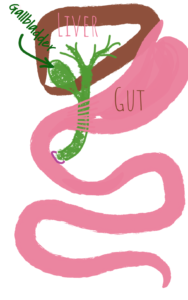Gallstones are very common in Australian society, and are often found on ultrasound when looking for the cause of abdominal pain or abnormal liver function tests. However, more than 80% of gallstones cause no problem and do not need to be treated.
What are they?
The liver does many essential things to keep us alive and well. It processes and breaks down nutrients which have been absorbed from the gut and filters out toxins. It makes hormones and other proteins such as those which contribute to blood clotting. It stores sugars, fats and proteins. And it makes bile.
The liver secretes the green, slimy bile into the bile ducts, which drains through the main common bile duct in to the gut. There, it mixes with the chewed food and breaks down the fats into microscopic particles to allow the vital nutrients to be absorbed. Between meals, a circular muscle around the common bile duct keeps it closed, so the bile is stored in an offshoot from the common bile duct: the gallbladder.

While the bile sits in the gallbladder, waiting for the next mealtime, the lining of the gallbladder absorbs water from it, making it more and more concentrated. It can become so concentrated that the bile and cholesterol salts can precipitate out, and these crystals can clump together to make sludge, and then – like a pearl in an oyster – can slowly grow into a stone. Or several stones.
In most people, these are innocent decorations which cause no trouble. However, if one of these stones happens to be sitting at the outlet of the gallbladder at the moment it is stimulated to contract and expel it’s bile into the common bile duct, it can become wedged in that narrow outlet. The gallbladder continues to contract, and like any muscle pushing against an immovable object, this can result in pain.
Biliary Colic is the pain caused in this situation. It is usually felt in the upper quarter of the abdomen, in the middle, just below the breastbone. It is constant and severe, and may be associated with nausea or a feeling like needing to pass wind or open the bowels. Many people feel the need to pace around or squirm. It is rare for the pain to last more than four hours, and some people find that it resolves with a vomit. Sometimes, the pain can radiate around the right side towards the back. Although it is very painful, it is not a threat to your health (any more than sore leg muscles after an unusually long run). It may occur 30-120 minutes after a meal (especially a rich meal).
If the pain lasts longer than 4 hours, or moves to the right side of the abdomen with tenderness just below the rib cage, or involves a fever, we call it cholecystitis. The gallbladder is now inflamed and may develop scarring. It may settle with antibiotics, but there is a high chance of further episodes.
If a stone is small enough to get out of the gallbladder into the common bile duct, more serious complications can occur. Choledocholithiasis means a stone in the bile duct, and it may slow the flow of bile out from the liver or stop it completely. Blocked bile ducts can injure the liver, resulting in jaundice (yellow skin, yellow sclera, very dark urine, very pale stools). When this flowing stream becomes a stagnant pond, infection becomes likely; this particular infection tends to cause such high fevers as to result in delerium and fainting. The stones in the bile duct can also irritate the pancreas and cause pancreatitis. 1% of pancreatitis is severe, and 1% of severe pancreatitis results in death. If you have any of the problems in this paragraph, please get immediate medical attention in a hospital.






